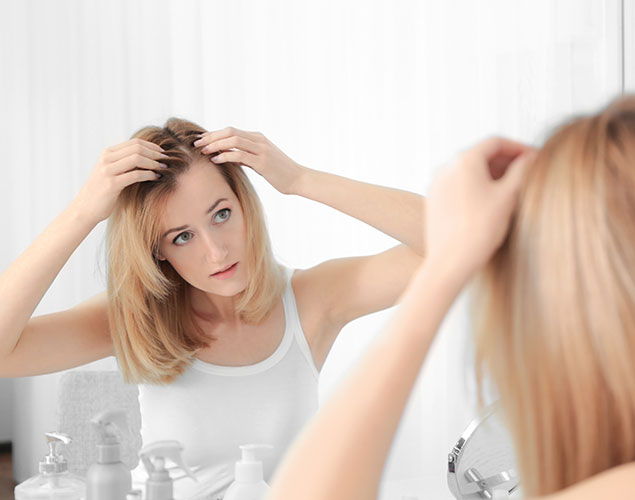Female Hair Loss
The human body is completely covered by hair follicles except for the palms of the hands, soles of the feet, genitals and lips. Most follicles are tiny and many of the hairs they produce do not grow long enough to protrude from the pore. The only living part of the hair is the bulb, which is anchored to the base of the follicle. The follicle supplies oxygen and nutrients to the bulb, and lubricates the hair shaft with an oil substance called sebum. There are many causes of hair loss, but only those that damage the follicles can make the loss permanent.
There are many stories of women experiencing this incredibly devastating condition—it is hard enough for a man to lose his hair, but at least it is socially acceptable. For a woman losing her hair the experience can be one thousand times more difficult. The discomfort and social factors surrounding a woman who is losing her hair can make the experience more difficult than for a man, and the complete lack of information or resources for help on the topic only compounds the problem. Confusion, fear, and anxiety can set in and the feeling of helplessness is paramount.
Nearly 40% of women by the age of 60 experience some form of hair loss.
Causes of Female Hair Loss
The most common causes of hair loss in women are hormonally related. Whether it be an overactive thyroid, or the after effects of menopause or pregnancy, there usually is a distinct reason why women lose their hair. The key is to find out what the reason is, and then to receive proper treatment. The most common reasons for hair loss in women are Alopecia Areata, Androgenetic Alopecia, Telogen Effluvium, and Loose Anagen Syndrome.
Alopecia Areata (hair loss/auto-immune)
Alopecia Areata is an autoimmune disease which means the immune system mistakenly attacks the cells of the body, and in this case the hair bulb. Typically a small patch of hair drops out leaving only a few stubby hairs. In some cases the hair can grow back within weeks or months, but other people are left with persistent bald spots.
Androgenetic Alopecia (patterned hair loss in women)
Hair loss in women tends to produce thinning over the top of the scalp rather than a patch of baldness. Minor degrees of patterned hair loss occur in over 55 percent of women as they age, however only about 20 percent of women develop moderate or severe hair loss. Androgenetic Alopecia is commonly related to extreme stress, deficiency in vitamins and minerals, a diet low in protein, anemia, hypothyroidism, hormone disregulation, or the use of birth control pills.
Telogen Effluvium
Condition that causes shedding of hair over the entire scalp, can be chronic but also may be acute following a stressful event, physical or emotional, or severe blood loss.
Loose Anagen Syndrome
A condition that causes hair to shed before its normal cycle is completed.

The most common reason for female hair loss
In our clinic, 95% of all female hair loss cases are from Androgenetic Alopecia (patterned hair loss). Androgenetic Alopecia is usually due to hormone irregularities and/or severe nutritional deficiencies caused by one or more of the following:
- Use of Birth Control Pills
- Pregnancy
- Severe Long-Term Stress
- Menopause
- Severe Mineral and Vitamin Deficiency
- Lack of Protein Intake
- Anemia
Women struggling with this disorder have usually exhausted all of the traditional medical testing and treatment methods to no avail. Physicians these days seem to have less and less education on many conditions, being proactive on of your own health is imperative to getting good treatment.
With our testing abilities and knowledge and experience in this area we have been able to quite effectively treat hair loss in women through the use of bio-identical hormone therapy, nutritional supplementation, Chinese herbology, and homeopathy.
